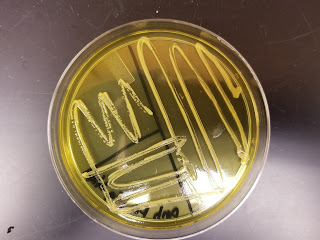The Lactobacillus Hustle
I was completing inhibition assays on my lil' Lactobacilli. I was trying to determine if they could inhibit the growth of a food pathogen like E. coli. So, I got a petri dish filled with MRS agar, dug a well, and inserted 500 microliters of MRS broth inoculated with a 24 hour, undiluted culture of each of the Lactobacillus species, acidophilus, plantarum, and rhamnosus. Then I spread lil E. coli around the top of each of the wells. All the research I read indicated that the two did not make good roomates, but what happened next could not have been anticipated.
E. coli just had his run of the place. I asked the Lactobacilli what happened. They informed me that E. coli was nice but could be a little aggressive at times. It was difficult keeping the place tidy while he was around. They suggested that I leave them alone in the well and then bring E coli by in a couple days. So I did. I left them alone in the well before I moved in E. coli. However, I was bamboozled! Lil' Lactobacillus had no intention of letting E. coli move in. I went back in a couple days and there was no sign of E. coli. I guess the research was right. These guys don't make good roommates.
Various species of Lactobacilli can inhibit the growth of pathogens like E. coli. Members of this genus group can lower the pH of the environment that makes it inhabitable for certain pathogens. However, results from our growth curve analysis indicated that it takes about 24 hours for the Lactobacillus to acidify the environment.


Comments
Post a Comment